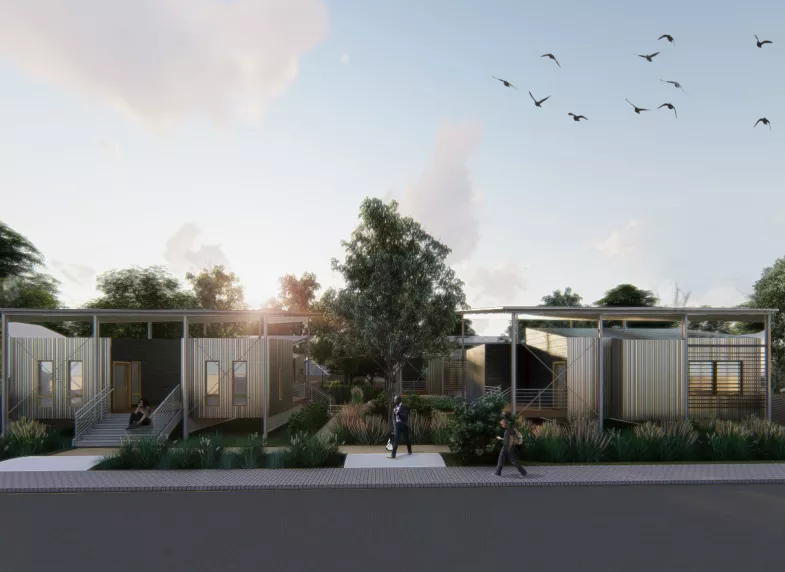
In this week's blog, Phius Co-Founder and Executive Director Katrin Klingenberg takes a look at the application of Phius standards in hot and humid climates as the first installment of our Hot and Humid blog series.
In 2018, a team of undergraduate students from Prairie View A&M in Houston were named “Grand Winner” in the Solar Decathlon Design Challenge.
The project was ambitious and humble at the same time. It aimed to rebuild a neighborhood and community that had been destroyed by multiple 500-year floods that had occurred in quick succession.
It was poetic and beautiful, too. Individual prefabbed flats combined with communal garden spaces within. It was an important testament to the effectiveness of Phius ZERO projects in hot and humid climates.
The home was designed to Phius super-efficient standards to ensure the lowest utility bills possible, maximum comfort, quiet, peace of mind, durability, indoor health, and habitability in case of natural disasters and power outages. The community was built on stilts high enough to not be affected by future floods. Each flat had its own “Fly” rooftop with photovoltaics on it for energy independence. Because the homes were so efficient to begin with, each unit would produce more than it consumed. All units were organized in a microgrid to share storage of excess energy for even greater resilience and islandability They would still be operational during outages, and during good times the community would benefit from selling excess production to the larger grid.
The project was a beautiful and comprehensive vision. The best part? Construction of a FlyFlat unit in Houston is now being planned.
It is not the first Phius project in a hot and humid climate, but it will be the best one. It represents the latest evolution and refinement of the Phius standard, and it represents why climate appropriate design is essential for success in hot and humid climates.
Successful Phius projects have been built in hot/humid climates over the past 10 years including in South-East Asia, which has one of the most challenging climates in terms of summer heat and humidity and cold winter temperatures.
Traditionally, passive design principles rely heavily on passive measures and on, yes, super-insulation. That emphasis does seem counterintuitive for hot climates, and in the early days, in practice it actually was problematic..
We learned that the non-granular “one metric fits all approach” and methodology indeed has a built-in cold climate bias. Insulation works great in cold climates, but in hot and humid climates, too much of it leads to increasing cooling demand and loads. Climate-specific cooling demand design targets and peak load targets were needed as a backstop. They inform the designer when measures such as insulation and internal gains actually drive up cooling loads instead of reducing them in hot and humid climates. Without such backstop targets, the designer essentially flies blind. If a design methodology does not have a specific cooling target, then there is nothing to let the designer know where the optimal spot for cooling is. It is a balancing act of measures that can counteract each other.
Cooling targets are not simply a mirror image of heating targets, and the optimal target is different for each climate. Heating is not a big deal in Houston, but cooling and dehumidification are. Passive measures really start to lose their punch when it comes to cooling, and efficient mechanical systems become critical much sooner than in a heating dominated climate.
So, is a Phius project design more difficult in a hot and humid climate? No – some of the passive and active design principles just have a different weight. With the correct climate appropriate design targets it is just as easy. Is it more expensive if it does not save as much as in the cold climate? No – it is just shifting some of the additional costs from passive envelope measures over to super-efficient systems measures.
And to close, a word on designing with resiliency in mind. Phius projects shine both in the short-term without additional back-up as well as the longer term.
Remember the recent extreme weather events in the South? A headline from the day after hurricane Ida swept across Louisiana read: “The levees held but the power grid folded”.
Most of the state was left without power, and temperatures in the aftermath were predicted to rise into the 100s.and that was after a ton of rain and flooding. Such high temps and humidity are life-threatening events on top of all the other hardship and destruction. One of the early Phius projects in Lafayette, Louisiana could have easily stayed comfortable for weeks with an electric car as back-up battery.
And then, in continental hot and humid places it occasionally gets super cold too. Remember the Texas winter event, when the grid folded, and people and pipes were freezing in homes? A Phius certified home in Austin stayed above 50 degrees even without back-up. With a small back-up system, no problem at all.
So, yes, Phius works in hot and humid climates because the Phius standard is climate appropriate.
And for everyone practicing in hot and humid climates, mark your 2023 calendar: PhiusCon 2023 will be in Houston Nov. 7-10
